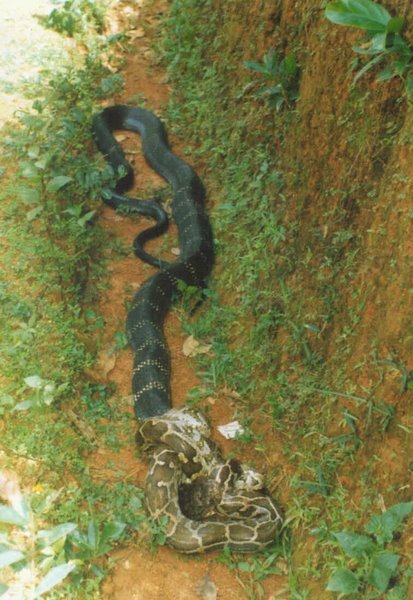
The King Cobra is currently known as the world´s longest venomous snake, it can reach up to 5.6 meters (18 feet) in length. Despite its large size, King Cobras are fast and agile. When confronted, they can raise up to one third of their bodies straight off the ground and still move forward to attack. They are easily irritated by close approaching objects or sudden movements. King Cobras attack quickly and the strike distance can be as high as 7 feet.
Native mainly throughout the rainforests and plains of India, southern China and southern Asia, the King Cobra is usually comfortable in trees, on land and in water. Its diet consists primarily of other venomous and non-venomous snakes. When food is scarce, it may also feed on lizards, eggs and small mammals. The King Cobras most common meal is the rat snake; this leads the King Cobra near to human settlements where there are a lot of rats. After a large meal, the snake may live for many months without another meal because of its slow metabolic rate. The venom of the King Cobra is not as potent as other venomous snakes, but on the other hand, the amount of neurotoxin that it can deliver in a single bite – up to two-tenths of a fluid ounce (seven milliliters) – is sufficient to kill 20 people, and can even kill an elephant within 3 hours. One bite from a King Cobra to a human can cause death within 15 minutes. Fortunately, these creatures are timid and avoid confrontation with humans as often as possible, but keep in mind that they are fiercely aggressive when cornered.
King Cobras are the only snakes in the world that build nests for their eggs. The female King Cobra is a very dedicated parent; she usually deposits 20 to 40 eggs and guards them until they start to hatch. When the eggs are hatched, instinct makes her leave the nest and find food to eat so that she does not eat her young. Despite the fact that cobras can hear, they are actually deaf to ambient noises, sensing ground vibrations in its place. When snake charmers play flute, the cobra is actually attracted by the shape and movements of the charmers flute, and not by the music it releases…

































